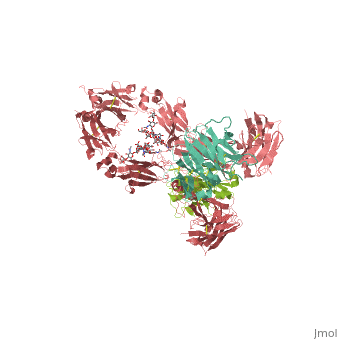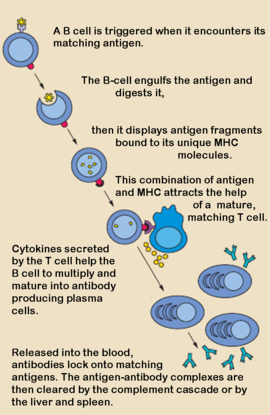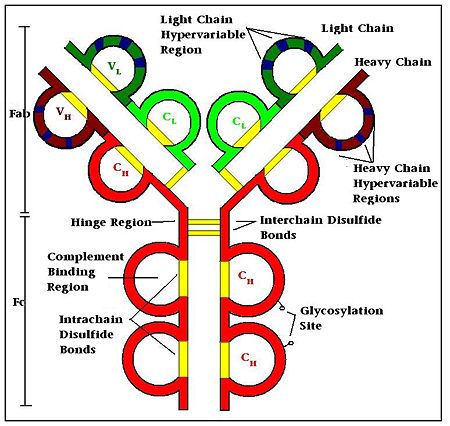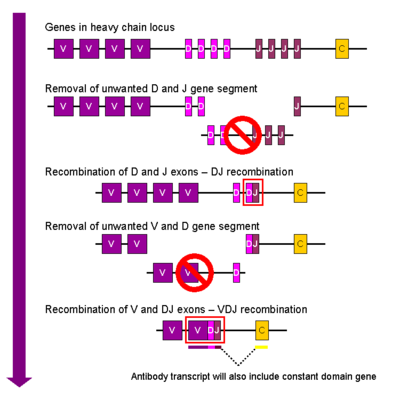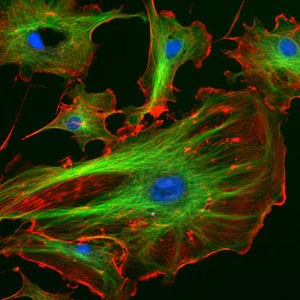Antibody
From Proteopedia
(Difference between revisions)
| Line 3: | Line 3: | ||
'''Antibodies''', also known as '''Immunoglobulins''' (Ig) are gamma globulin proteins, primarily found in the blood of vertebrates. These [[glycoproteins]] serve as a critical component of the immune system when the host fails to activate alternative compliment pathways or phagocytic cells in response to invading microorganisms or other [http://en.wikipedia.org/wiki/Antigen antigens]. The incredible specificity with which immunoglobulins bind to an antigen is based upon structural complementarity between the antigen and antibody <scene name='Antibody/1hzh_heavy_chains/1'>heavy </scene>and <scene name='Antibody/1hzh_light_chains/1'>light chains </scene>. It is this specificity that has made <scene name='Antibody/1hzh_starting_scene/3'>antibodies</scene> a critical component in laboratory and medical research. See more in<br /> | '''Antibodies''', also known as '''Immunoglobulins''' (Ig) are gamma globulin proteins, primarily found in the blood of vertebrates. These [[glycoproteins]] serve as a critical component of the immune system when the host fails to activate alternative compliment pathways or phagocytic cells in response to invading microorganisms or other [http://en.wikipedia.org/wiki/Antigen antigens]. The incredible specificity with which immunoglobulins bind to an antigen is based upon structural complementarity between the antigen and antibody <scene name='Antibody/1hzh_heavy_chains/1'>heavy </scene>and <scene name='Antibody/1hzh_light_chains/1'>light chains </scene>. It is this specificity that has made <scene name='Antibody/1hzh_starting_scene/3'>antibodies</scene> a critical component in laboratory and medical research. See more in<br /> | ||
[[IgA]]<br /> | [[IgA]]<br /> | ||
| + | [[IgG Branco]]<br /> | ||
[[Monoclonal Antibody]].<br /> | [[Monoclonal Antibody]].<br /> | ||
For Anti-HIV Fab see [[Human Fab PG16]]<br /> | For Anti-HIV Fab see [[Human Fab PG16]]<br /> | ||
Revision as of 10:46, 10 February 2016
| |||||||||||
3D Structures of Immunoglobulin
Updated on 10-February-2016
Humanized mouse antibody (hmFab) is a modified mFab which resembles more hFab.
References
- ↑ 1.0 1.1 1.2 1.3 1.4 1.5 1.6 Roit, I. M. Roit's Essential Immunology. Oxford: Blackwell Science Ltd., 1997.
- ↑ Parker DC. T cell-dependent B cell activation. Annu Rev Immunol. 1993;11:331-60. PMID:8476565 doi:http://dx.doi.org/10.1146/annurev.iy.11.040193.001555
- ↑ Rus H, Cudrici C, Niculescu F. The role of the complement system in innate immunity. Immunol Res. 2005;33(2):103-12. PMID:16234578 doi:10.1385/IR:33:2:103
- ↑ Roux KH. Immunoglobulin structure and function as revealed by electron microscopy. Int Arch Allergy Immunol. 1999 Oct;120(2):85-99. PMID:10545762
- ↑ Putnam FW, Liu YS, Low TL. Primary structure of a human IgA1 immunoglobulin. IV. Streptococcal IgA1 protease, digestion, Fab and Fc fragments, and the complete amino acid sequence of the alpha 1 heavy chain. J Biol Chem. 1979 Apr 25;254(8):2865-74. PMID:107164
- ↑ Woof JM, Burton DR. Human antibody-Fc receptor interactions illuminated by crystal structures. Nat Rev Immunol. 2004 Feb;4(2):89-99. PMID:15040582 doi:10.1038/nri1266
- ↑ Putnam FW, Liu YS, Low TL. Primary structure of a human IgA1 immunoglobulin. IV. Streptococcal IgA1 protease, digestion, Fab and Fc fragments, and the complete amino acid sequence of the alpha 1 heavy chain. J Biol Chem. 1979 Apr 25;254(8):2865-74. PMID:107164
- ↑ Harris LJ, Larson SB, Hasel KW, McPherson A. Refined structure of an intact IgG2a monoclonal antibody. Biochemistry. 1997 Feb 18;36(7):1581-97. PMID:9048542 doi:http://dx.doi.org/10.1021/bi962514+
- ↑ Hochman J, Inbar D, Givol D. An active antibody fragment (Fv) composed of the variable portions of heavy and light chains. Biochemistry. 1973 Mar 13;12(6):1130-5. PMID:4569769
- ↑ Putnam FW, Liu YS, Low TL. Primary structure of a human IgA1 immunoglobulin. IV. Streptococcal IgA1 protease, digestion, Fab and Fc fragments, and the complete amino acid sequence of the alpha 1 heavy chain. J Biol Chem. 1979 Apr 25;254(8):2865-74. PMID:107164
- ↑ Woof JM, Burton DR. Human antibody-Fc receptor interactions illuminated by crystal structures. Nat Rev Immunol. 2004 Feb;4(2):89-99. PMID:15040582 doi:10.1038/nri1266
- ↑ Wright A, Morrison SL. Effect of glycosylation on antibody function: implications for genetic engineering. Trends Biotechnol. 1997 Jan;15(1):26-32. PMID:9032990 doi:10.1016/S0167-7799(96)10062-7
- ↑ Heyman B. Complement and Fc-receptors in regulation of the antibody response. Immunol Lett. 1996 Dec;54(2-3):195-9. PMID:9052877
- ↑ Ravetch JV, Bolland S. IgG Fc receptors. Annu Rev Immunol. 2001;19:275-90. PMID:11244038 doi:19/1/275
- ↑ Fanning LJ, Connor AM, Wu GE. Development of the immunoglobulin repertoire. Clin Immunol Immunopathol. 1996 Apr;79(1):1-14. PMID:8612345
- ↑ Diaz M, Casali P. Somatic immunoglobulin hypermutation. Curr Opin Immunol. 2002 Apr;14(2):235-40. PMID:11869898
- ↑ Borghesi L, Milcarek C. From B cell to plasma cell: regulation of V(D)J recombination and antibody secretion. Immunol Res. 2006;36(1-3):27-32. PMID:17337763 doi:10.1385/IR:36:1:27
- ↑ Durandy A. Activation-induced cytidine deaminase: a dual role in class-switch recombination and somatic hypermutation. Eur J Immunol. 2003 Aug;33(8):2069-73. PMID:12884279 doi:10.1002/eji.200324133
- ↑ CHOWN B, LEWIS M, KAITA K. A new Kell blood-group phenotype. Nature. 1957 Oct 5;180(4588):711. PMID:13477267
- ↑ Burnette WN. "Western blotting": electrophoretic transfer of proteins from sodium dodecyl sulfate--polyacrylamide gels to unmodified nitrocellulose and radiographic detection with antibody and radioiodinated protein A. Anal Biochem. 1981 Apr;112(2):195-203. PMID:6266278
- ↑ Brehm-Stecher BF, Johnson EA. Single-cell microbiology: tools, technologies, and applications. Microbiol Mol Biol Rev. 2004 Sep;68(3):538-59. PMID:15353569 doi:10.1128/MMBR.68.3.538-559.2004
Additional Pages
See Also
- Variable Lymphocyte Receptors
- Antibody at High school teachers' resources, where you will find tutorials on antibody structure.
- Antibodies at Wikipedia.
Proteopedia Page Contributors and Editors (what is this?)
David Canner, Michal Harel, Alexander Berchansky, Wayne Decatur, Mark Hoelzer, Eric Martz, Jaime Prilusky, Marius Mihasan
